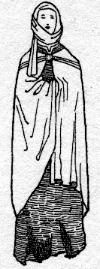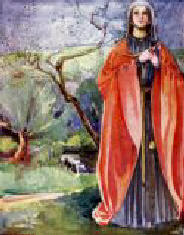

Cloaks and Capes
Cloaks and capes were worn by both men and women. Cloaks were very useful in keeping warm, and they added another dimension to one's outfit. Women wore them over gowns, and men over tunics and pants. Cloaks varied in length and style, as well as by how they were tied. Two examples of cloaks are below. The two examples don't differ much in cut and length, but the way they are fastened is fairly different. The cloak on the left has been fastened at the throat by a clasp. Attached to the clasp is two to three bands of cord, made of varying materials depending on the wearer's wealth, that circled the shoulders and attached to the clasp on the other side. This served to hug the cloak tight about the shoulders and provide more definition as to the wearer's profile. Another method, shown on the right, was to loosely fasten it with a cord clasp. Suffice to say that the tie on the left kept much less heat from escaping, keeping the wearer far warmer.


A cloak could signify much about its wearer's status. The quality of the clasp, the length of the cloak, the richness of the material, the color of the cloak- all these showed how wealthy the person wearing the cloak was. Cloaks sometimes had hoods, but often the hood was separate from the cloak. Sometimes the cloaks had small slits for the arms, and some types were "full circle" cloaks- that is, they reached all the way around the body and were normally very long, unlike the two above. A picture of a full-circle cloak is shown below.

Capes were pretty much just short, decorative cloaks. They were typically worn by men, and were more for style than for warmth.
For more information:
 |
Cloaks - Messages |